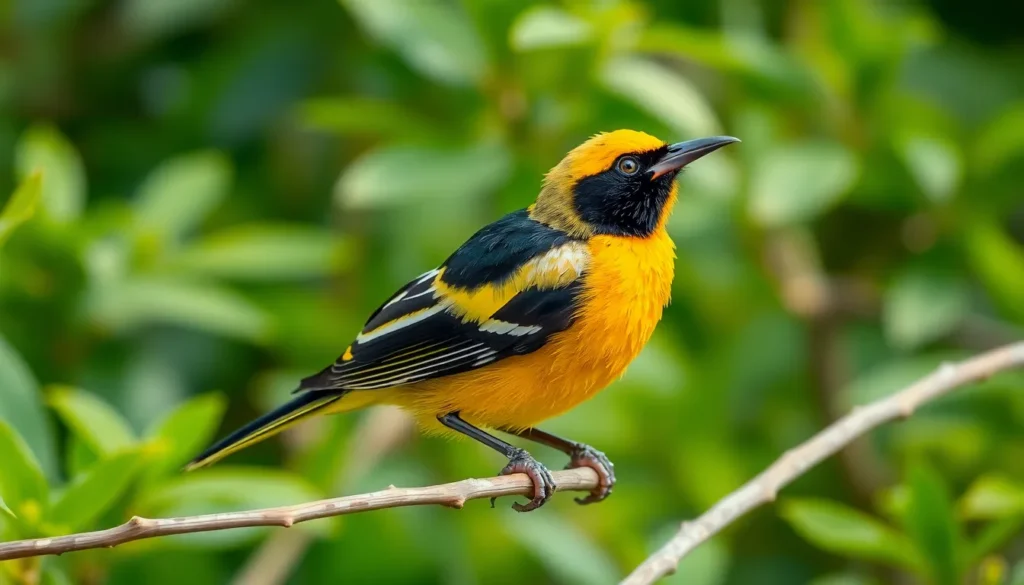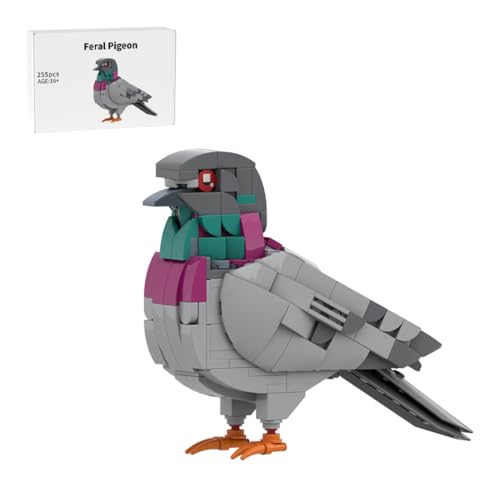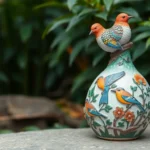We’ve all marveled at intricate architecture but few creatures match the engineering prowess of weaver birds. These remarkable avian architects construct some of nature’s most sophisticated nests using nothing but their beaks and an innate understanding of structural design.
Found primarily across Africa and Asia these small songbirds transform simple grass and twigs into elaborate hanging masterpieces. Each species has perfected its own unique weaving technique passed down through generations of meticulous craftsmanship.
What makes weaver birds truly fascinating isn’t just their construction skills—it’s their complex social behaviors and the incredible variety of nest designs they create. From the massive communal apartments of sociable weavers to the perfectly woven entrance tunnels of village weavers we’re about to explore why these feathered engineers deserve our attention and admiration.
What Is a Weaver Bird?
Weaver birds represent a fascinating family of small passerine songbirds renowned for their exceptional nest construction abilities. These remarkable creatures belong to the family Ploceidae and comprise over 100 distinct species distributed primarily across sub-Saharan Africa and parts of Asia.
We observe weaver birds as compact songbirds typically measuring 4 to 10 inches in length. Males display vibrant yellow and black plumage during breeding season while females maintain more subdued brown and olive coloration throughout the year. Their sturdy beaks serve as precision tools for weaving intricate nests from natural materials.
Physical characteristics include strong legs adapted for gripping branches and specialized bill shapes that vary among species. Village weavers showcase thick conical beaks perfect for seed cracking while forest species possess thinner bills suited for insect capture.
Habitat preferences span diverse environments from savannas and grasslands to forest edges and urban areas. Southern red bishops inhabit wetland margins whereas sociable weavers thrive in arid regions of southern Africa.
Behavioral patterns demonstrate complex social structures with some species forming massive colonies containing thousands of individuals. Cape weavers establish territorial breeding grounds while others like buffalo weavers engage in cooperative breeding systems where multiple pairs share communal nesting sites.
Diet composition varies by species but typically includes seeds grasses insects and fruits. Granivorous species consume millet sorghum and other small seeds while insectivorous varieties target beetles caterpillars and flying termites during breeding seasons.
These extraordinary architects earned their common name through their unparalleled ability to weave elaborate suspended nests using only plant fibers strips of leaves and their natural instincts.
Physical Characteristics and Identification
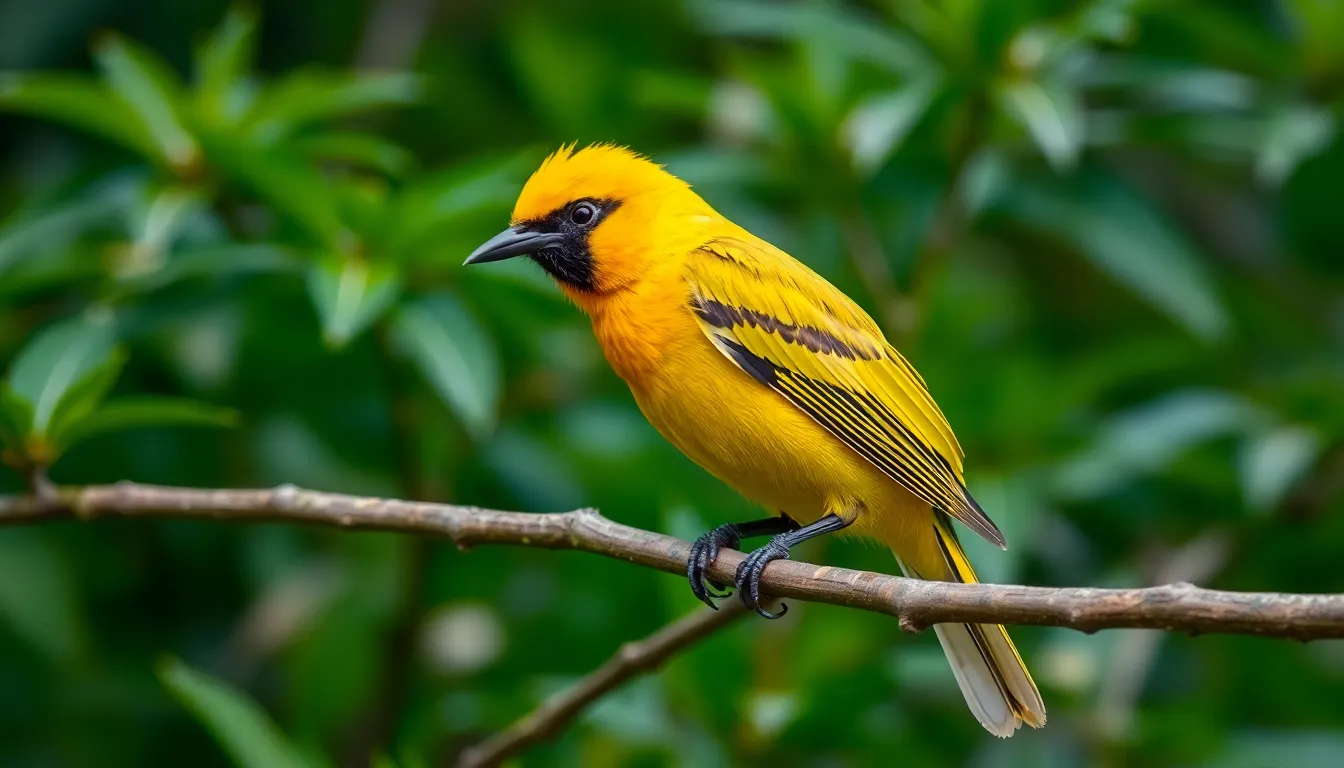
Weaver birds display remarkable physical diversity across their 100+ species, making identification both fascinating and challenging for bird enthusiasts. These distinctive songbirds possess exact anatomical features that directly support their renowned nest-building capabilities.
Size and Body Structure
Most weaver bird species measure between 4 to 10 inches in length, with body weights ranging from 0.5 to 2.5 ounces depending on the exact species. Compact bodies characterize these birds, featuring proportionally large heads that house their specialized beaks. Their sturdy legs end in strong, curved claws that provide exceptional gripping power on branches and nesting materials.
The beak represents the most crucial identifying feature of weaver birds. Thick, conical beaks dominate seed-eating species like the Village Weaver, while thinner, more pointed beaks appear in insect-eating varieties such as the Forest Weaver. Wings typically span 6 to 8 inches across, with pointed tips that enable agile flight through dense vegetation.
Plumage and Coloration
Breeding season transforms many weaver bird species into vibrant displays of yellow, orange, and black coloration. Males often develop bright golden yellow bodies with contrasting black masks around their eyes and throats. Red-headed Weavers showcase brilliant crimson caps, while Spectacled Weavers display distinctive white eye rings against dark facial patches.
Non-breeding plumage appears significantly more subdued across most species. Browns, grays, and muted yellows replace the vivid breeding colors, creating effective camouflage during vulnerable periods. Streaked patterns frequently appear on the back and wings, particularly in ground-foraging species like the Scaly Weaver.
Sexual Dimorphism
Male weaver birds consistently outshine females in terms of coloration intensity and pattern complexity. During breeding season, males develop their most spectacular plumage to attract mates and establish territories. Female weavers maintain earth-tone coloring year-round, featuring browns, tans, and olive greens that provide camouflage while incubating eggs.
Size differences between males and females remain minimal in most weaver bird species, with males typically measuring only 5-10% larger than females. Behavioral displays rather than physical size determine male dominance and mating success. Females often possess slightly more pointed beaks than males, reflecting their primary role in fine nest maintenance and chick feeding activities.
Habitat and Geographic Distribution
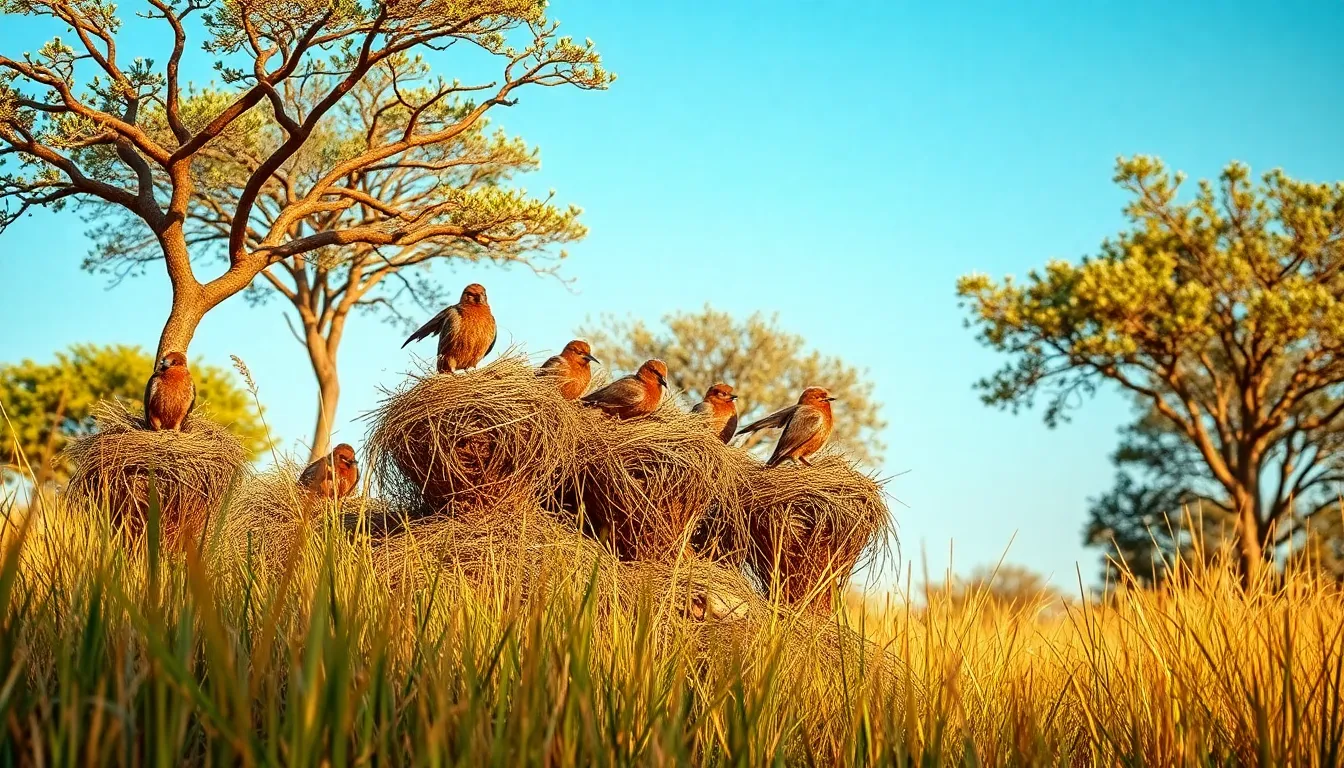
Weaver birds occupy diverse territories across multiple continents, with their distribution patterns reflecting millions of years of evolutionary adaptation. We find these remarkable architects in regions where suitable nesting materials and food sources converge to support their complex colonial lifestyles.
Natural Range
Africa serves as the primary stronghold for weaver bird populations, hosting approximately 80% of all species within the Ploceidae family. The continent’s savannas, grasslands, and woodland edges provide optimal conditions for 57 distinct species, including the iconic Village Weaver (Ploceus cucullatus) and Southern Red Bishop (Euplectes orix).
Asia represents the secondary distribution center, supporting 29 weaver bird species across its tropical and subtropical regions. Countries like India, Sri Lanka, and Southeast Asian nations house species such as the Baya Weaver (Ploceus philippinus) and Asian Golden Weaver (Ploceus hypoxanthus). These Asian populations demonstrate unique behavioral adaptations that distinguish them from their African relatives.
Madagascar hosts several endemic species, including the Sakalava Weaver (Ploceus sakalava) and Nelicourvi Weaver (Ploceus nelicourvi). The island’s isolation created evolutionary pressures that produced specialized feeding behaviors and nesting techniques found nowhere else on Earth.
| Region | Species Count | Notable Examples |
|---|---|---|
| Sub-Saharan Africa | 57 | Village Weaver, Southern Red Bishop |
| Asia | 29 | Baya Weaver, Asian Golden Weaver |
| Madagascar | 17 | Sakalava Weaver, Nelicourvi Weaver |
| Indian Ocean Islands | 8 | Mauritius Fody, Seychelles Fody |
Preferred Environments
Grasslands and savannas attract the highest concentrations of weaver bird colonies due to abundant grass seeds and suitable nesting materials. These open habitats provide the 6-foot grass stems essential for constructing their elaborate suspended nests, while offering clear sightlines for predator detection.
Acacia woodlands create ideal micro-environments where weaver birds establish some of their largest colonies. The thorny branches provide natural protection from climbing predators, while the trees’ seasonal flowering cycles offer protein-rich insects during breeding seasons. Colony sizes in these environments often exceed 200 breeding pairs.
Wetland edges and riparian zones support specialized weaver bird species that exploit aquatic food sources. These areas provide the flexible reed materials preferred by species like the Cape Weaver (Ploceus capensis), whose nests require exact moisture content for optimal durability.
Agricultural landscapes increasingly serve as secondary habitats for adaptable weaver bird species. Rice paddies, wheat fields, and cultivated gardens offer concentrated food sources, though human activity can disrupt traditional nesting cycles. Species like the Village Weaver demonstrate remarkable flexibility in exploiting these human-modified environments.
Urban parks and botanical gardens provide refuge habitats where weaver birds adapt their colonial behaviors to smaller spaces. These environments typically support 5-15 breeding pairs compared to the 50-300 pairs found in natural colonies, yet they serve crucial roles in maintaining genetic diversity within fragmented populations.
Behavior and Social Structure
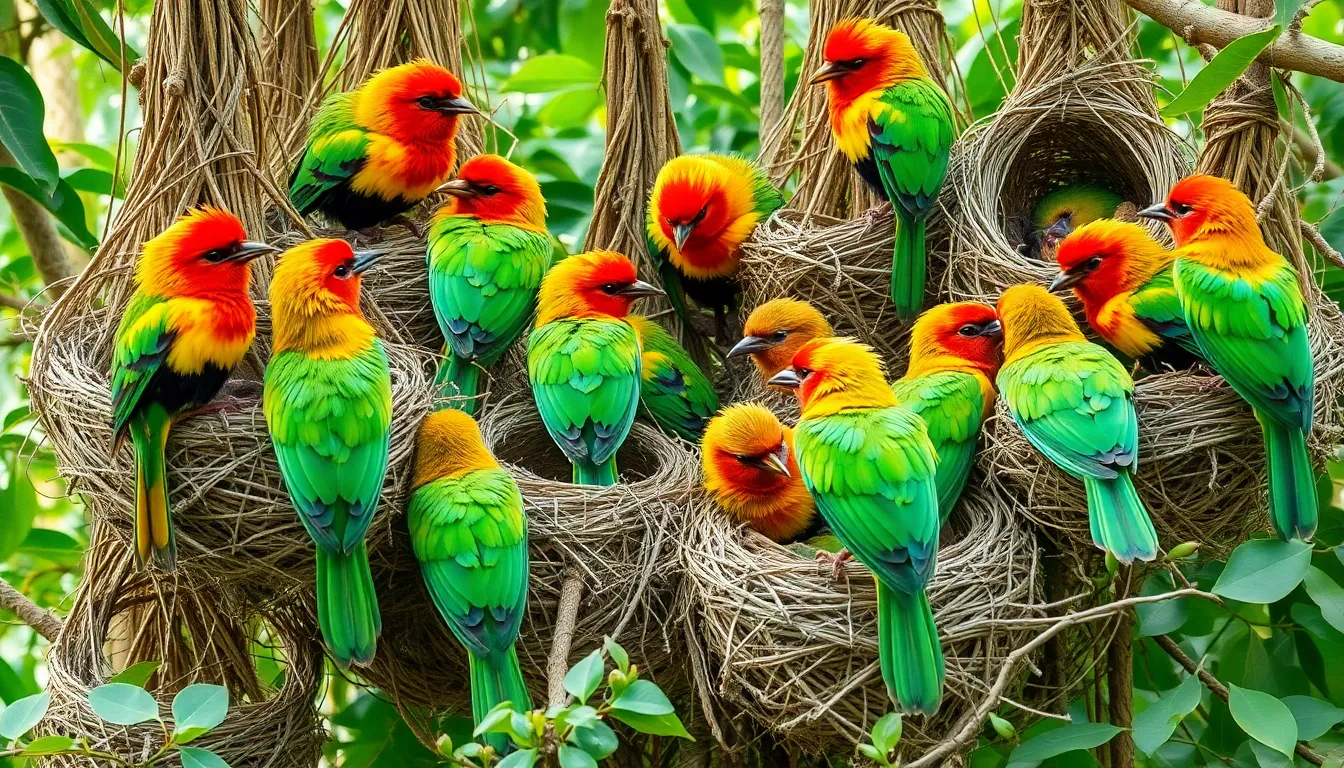
Weaver bird behavior centers around complex social interactions that drive their remarkable colonial lifestyles. These intricate behavioral patterns shape everything from breeding success to survival strategies across different species.
Mating and Breeding Patterns
Male weaver birds establish territories during breeding season by constructing multiple nests to attract potential mates. Competition among males intensifies as they display their architectural skills, with females selecting partners based on nest quality and construction precision. Polygamous mating systems dominate most weaver species, allowing successful males to mate with 2 to 6 females per breeding season.
Breeding colonies form when environmental conditions provide abundant food resources and suitable nesting materials. Village Weavers create colonies containing 20 to 100 nests, while Sociable Weavers construct massive communal structures housing up to 500 breeding pairs. Females inspect male-built nests thoroughly, examining entrance tunnels, chamber dimensions, and overall structural integrity before accepting or rejecting suitors.
Synchronized breeding occurs within colonies, with most pairs laying eggs during optimal seasonal conditions. Females typically produce 2 to 4 eggs per clutch, incubating them for 12 to 14 days while males continue attracting additional mates. Chick-rearing responsibilities fall primarily on females, though males occasionally assist with feeding duties in monogamous species like the Red-billed Quelea.
Flocking and Communication
Weaver bird flocks demonstrate sophisticated coordination patterns that enhance foraging efficiency and predator detection. Mixed-species flocks commonly include 50 to 200 individuals during non-breeding seasons, combining different weaver species with other seed-eating birds. These assemblages exploit diverse food sources while maintaining constant vigilance against aerial and terrestrial threats.
Vocal communication systems vary significantly among weaver species, incorporating distinct call types for different social contexts. Alarm calls alert colony members to approaching dangers, while contact calls maintain flock cohesion during long-distance flights. Male weaver birds produce elaborate songs containing 15 to 30 distinct note patterns, serving both territorial defense and mate attraction functions.
Social hierarchies emerge within established colonies, determined by factors including nest-building success, territory quality, and breeding experience. Dominant males secure prime nesting locations near colony centers, accessing better protection and increased mating opportunities. Subordinate individuals occupy peripheral positions but gain valuable experience observing successful breeding behaviors.
Cooperative behaviors extend beyond basic flock coordination, with some species captivating in communal nest maintenance and shared predator mobbing. Red-headed Weavers participate in group nest repairs, contributing materials and labor to maintain colony infrastructure. Information transfer occurs through observational learning, allowing younger birds to acquire complex weaving techniques and optimal foraging strategies from experienced colony members.
The Art of Nest Building
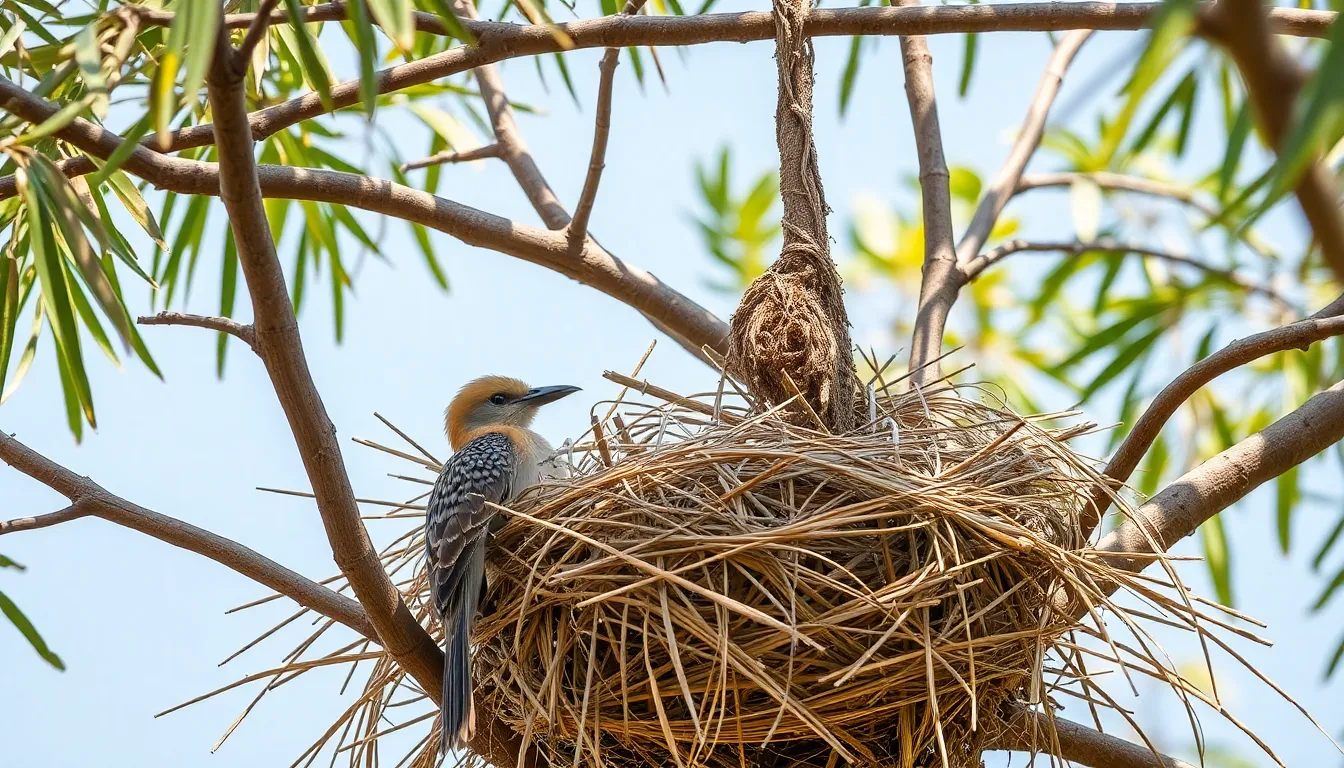
The architectural mastery of weaver birds represents one of nature’s most sophisticated construction projects. These remarkable engineers transform simple grass fibers and twigs into intricate structures that rival human craftsmanship.
Construction Techniques
Male weaver birds employ their specialized beaks as the primary tools for creating complex nest structures. Strip by strip, they weave fresh green grass stems through existing framework, maintaining consistent tension throughout the construction process. Starting with a simple slip knot around a sturdy branch, males gradually expand the structure by adding loops and knots in precise patterns.
Bending techniques play a crucial role in shaping the nest’s architectural form. Males select grass stems approximately 12 to 18 inches in length, ensuring optimal flexibility during the weaving process. Each stem gets stripped of leaves to create smooth working material that won’t snag during construction.
Knot tying demonstrates remarkable precision as males secure each grass strand with half hitches and overhand knots. Testing occurs continuously throughout construction, with males pulling and tugging at connection points to verify structural integrity. Failed sections get dismantled immediately, forcing males to restart portions that don’t meet quality standards.
Quality control drives the entire construction process as females inspect each nest before acceptance. Males invest 3 to 6 hours daily during peak building season, completing structures within 5 to 12 days depending on species and complexity.
Nest Types and Variations
Colonial apartment complexes represent the most impressive weaver bird constructions, with some structures housing over 500 breeding pairs. Village Weavers create communal designs where individual chambers connect through shared entrance galleries. These massive structures can weigh over 2,000 pounds and measure up to 20 feet in diameter.
Pendant nests showcase individual artistry as males suspend elaborate chambers from thin branches. Baya Weavers excel at creating flask shaped structures with long entrance tunnels that extend 6 to 12 inches below the main chamber. The tunnel design prevents snakes and other predators from accessing eggs and chicks.
Domed structures feature complete roof coverage with side entrances that provide weather protection. Red Bishops construct these compact designs using fine grass materials woven in tight circular patterns. Chamber interiors measure approximately 4 inches in diameter, creating cozy spaces for 2 to 4 eggs.
Retort shaped nests combine the benefits of pendant and domed designs through specialized construction techniques. Southern Masked Weavers create these sophisticated structures with both top and bottom chambers connected by internal passages. The lower chamber serves as a false entrance while the upper area houses actual nesting activities.
| Nest Type | Species Example | Construction Time | Typical Size | Unique Features |
|---|---|---|---|---|
| Colonial | Village Weaver | 10-15 days | 6-20 feet diameter | Multiple chambers, shared entrances |
| Pendant | Baya Weaver | 5-8 days | 6-8 inches wide | Long entrance tunnel |
| Domed | Red Bishop | 7-10 days | 4-5 inches diameter | Complete roof coverage |
| Retort | Southern Masked Weaver | 12-18 days | 8-10 inches tall | Dual chamber system |
Diet and Feeding Habits
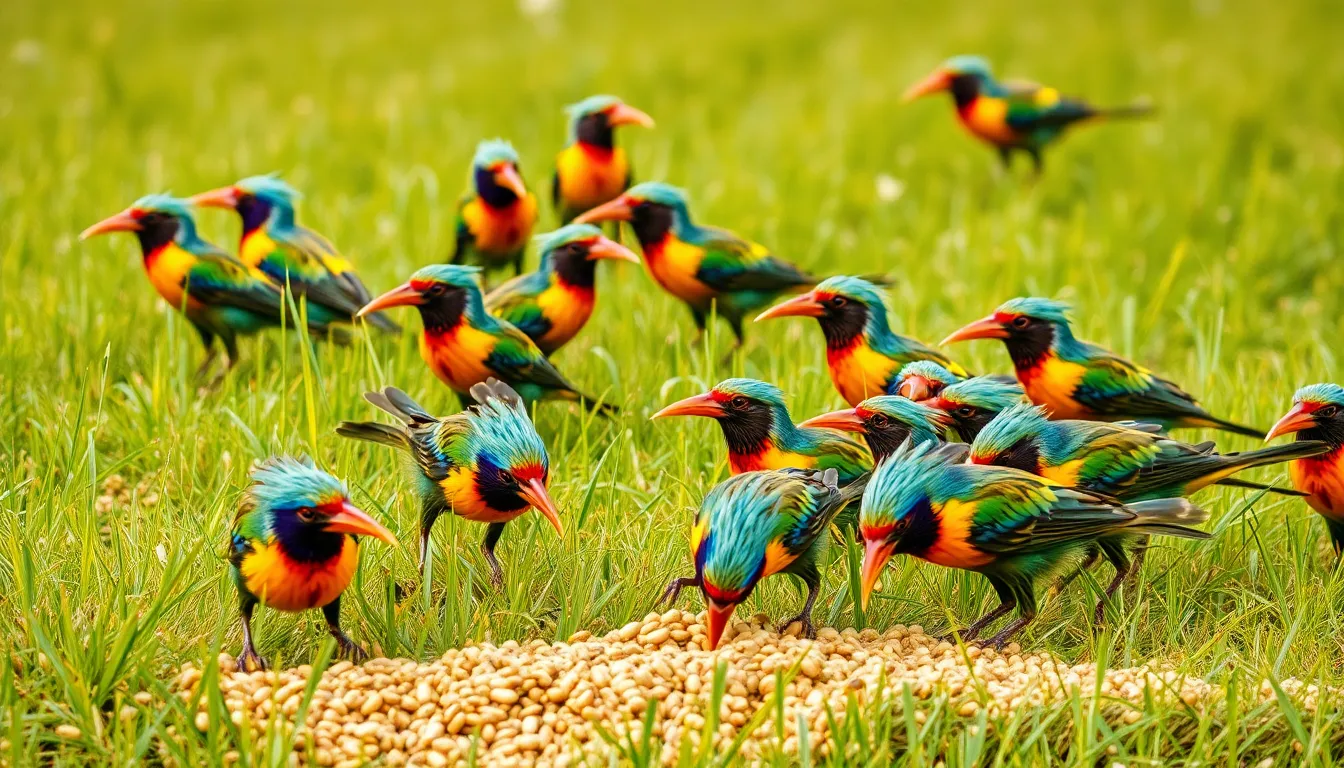
Weaver birds maintain diverse dietary preferences that vary significantly across species and seasons. Seeds form the primary food source for most weaver species, with grass seeds, millet, and sorghum comprising 60-80% of their daily intake during non-breeding periods. Insects become increasingly important during breeding season, providing essential proteins for growing chicks and egg production.
Primary Food Sources:
| Food Type | Percentage of Diet | Peak Season | Nutritional Value |
|---|---|---|---|
| Grass seeds | 50-70% | Dry season | High carbohydrates |
| Insects | 20-40% | Breeding season | High protein |
| Fruits | 5-15% | Wet season | Vitamins and sugars |
| Nectar | 5-10% | Flowering periods | Quick energy |
Foraging behavior adapts to seasonal food availability, with weaver birds forming mixed-species flocks of 50-200 individuals during the dry season. These flocks move systematically across grasslands and agricultural areas, exploiting different food patches throughout the day. Ground foraging occurs primarily in the early morning and late afternoon when temperatures remain moderate.
Seasonal Dietary Shifts:
During breeding season, protein requirements increase dramatically as females produce eggs and both parents feed nestlings. Adult weaver birds consume up to 15 grams of insects daily during peak chick-rearing periods, including caterpillars, beetles, aphids, and termites. Nestlings receive exclusively insect prey for their first 10-12 days of life.
Agricultural landscapes provide abundant feeding opportunities, with weaver birds accessing cultivated crops like rice, wheat, and sunflower seeds. Village Weavers and Red-billed Queleas often form massive flocks exceeding 10,000 individuals that can consume several tons of grain per day across affected farmlands.
Feeding Techniques:
Specialized beak adaptations enable different feeding strategies across weaver species. Seed-eating species possess robust, conical beaks designed for cracking tough grain hulls, while insectivorous species feature more slender, pointed bills for capturing small prey. Some species demonstrate remarkable flexibility, switching between ground foraging and aerial insect catching based on food availability.
Water requirements remain minimal for most weaver species, as they obtain sufficient moisture from their food sources. But, breeding colonies typically establish near water sources, with adults making regular drinking trips during hot periods and bringing water to nestlings in specialized throat pouches.
Nutritional Adaptations:
Digestive systems vary among weaver species based on their primary food sources. Granivorous species possess enlarged gizzards with strong muscular walls for grinding seeds, while insectivorous species maintain longer intestinal tracts for efficient protein absorption. These adaptations allow weaver birds to exploit diverse ecological niches within their shared habitats.
Species Diversity
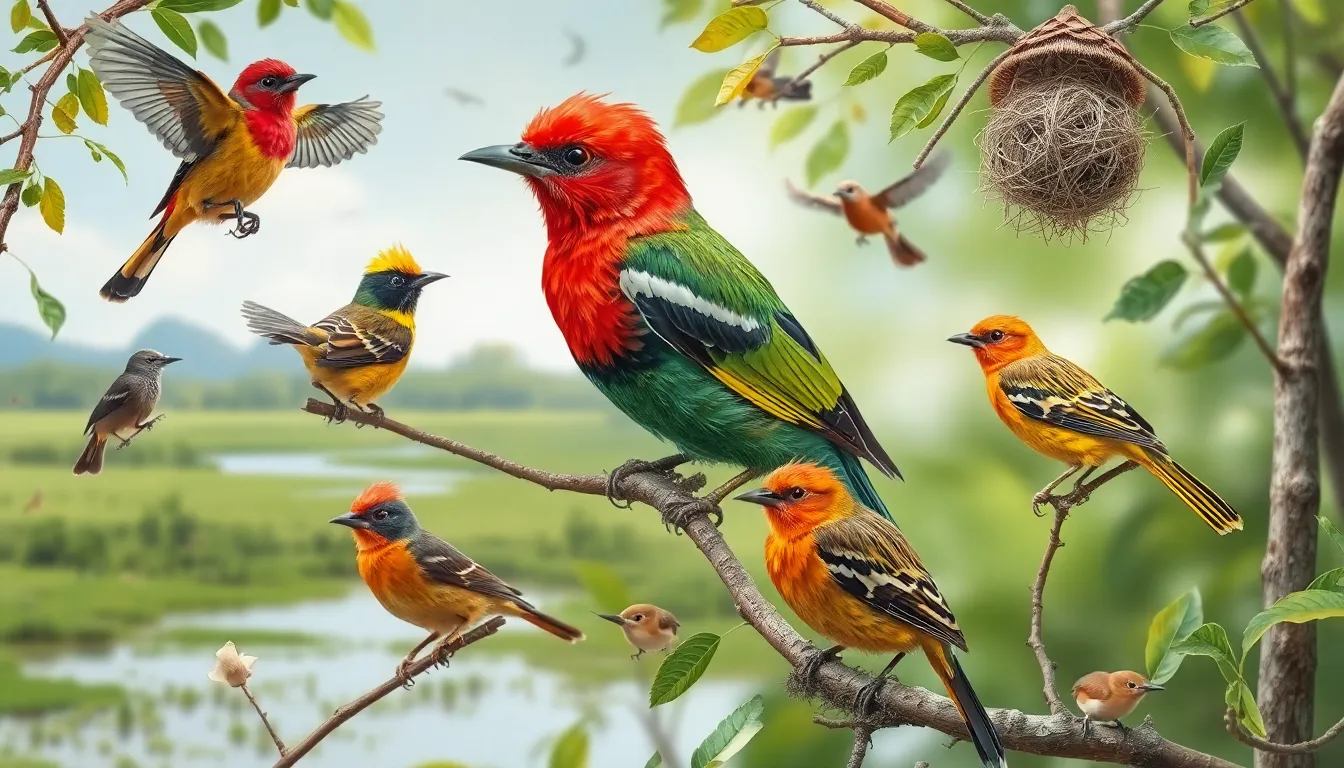
Weaver bird species showcase remarkable taxonomic richness across their global range, with over 100 distinct species distributed primarily throughout Africa and Asia. Each species exhibits unique adaptations in plumage patterns, nest architecture, and behavioral characteristics that reflect millions of years of evolutionary specialization.
African Weavers
African weaver birds represent the most diverse concentration of Ploceidae species, with 57 distinct varieties inhabiting the continent’s varied ecosystems. Village Weavers (Ploceus cucullatus) dominate savanna regions and construct massive colonial nests containing up to 200 individual chambers. Southern Red Bishops (Euplectes orix) display brilliant scarlet breeding plumage and prefer wetland margins where they weave basket-shaped nests suspended over water.
Red-billed Queleas (Quelea quelea) form the largest flocks, with individual colonies reaching populations of 1.5 million birds during peak breeding seasons. Cape Weavers (Ploceus capensis) exhibit sexual dimorphism through males’ bright yellow heads contrasted with females’ olive-brown coloration. Spectacled Weavers (Ploceus ocularis) create retort-shaped nests with distinctive downward-facing entrance tubes measuring 15-20 centimeters in length.
Madagascar hosts 5 endemic species including the endangered Sakalava Weaver (Ploceus sakalava) and forest-dwelling Nelicourvi Weaver (Ploceus nelicourvi). Golden Palm Weavers (Ploceus bojeri) construct pendulous nests exclusively in coconut palms, while Thick-billed Weavers (Amblyospiza albifrons) possess specialized beaks adapted for extracting seeds from tough sedge pods.
Asian Species
Asian weaver bird populations cover 29 species distributed across tropical and subtropical regions from India to Southeast Asia. Baya Weavers (Ploceus philippinus) represent the most widespread Asian species and construct bottle-shaped nests with entrance tunnels extending up to 60 centimeters below the main chamber. Asian Golden Weavers (Ploceus hypoxanthus) inhabit mangrove ecosystems and weave nests using saltwater-resistant palm fibers.
Streaked Weavers (Ploceus manyar) prefer reed beds and grasslands where they create compact spherical nests camouflaged among tall vegetation. Forest Weavers (Ploceus bicolor) exhibit black and yellow plumage patterns and build nests in forest canopies using vine fibers and moss. Yellow Weavers (Ploceus megarhynchus) possess enlarged beaks measuring 2.5 centimeters in length for processing large seeds.
Finn’s Weavers (Ploceus megarhynchus) create communal roost structures accommodating 30-50 individuals during non-breeding periods. Bengal Weavers (Ploceus benghalensis) construct nests with multiple entrance chambers and have adapted to urban environments including city parks and gardens.
Weaver Birds as Pets
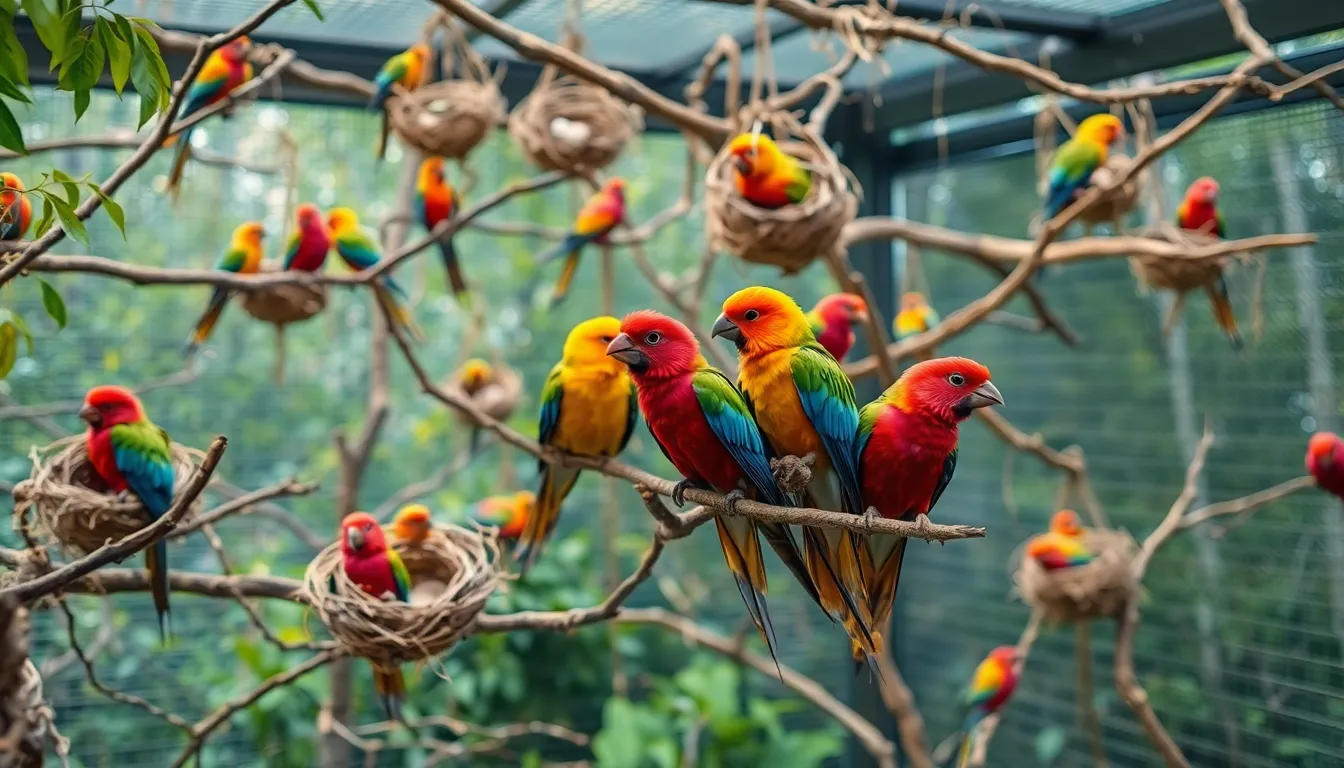
Weaver birds captivate enthusiasts with their intricate behaviors, yet keeping them as pets presents important challenges that most bird owners can’t adequately address. Their complex social structures and specialized environmental needs make them unsuitable companions for typical household settings.
Care Requirements
Housing weaver birds requires enormous flight enclosures measuring at least 20 feet long by 15 feet wide by 12 feet high to accommodate their natural flocking behaviors. Standard bird cages restrict their movement patterns and cause severe psychological stress that manifests in feather plucking and aggressive behaviors.
Temperature control becomes critical as these birds thrive in environments between 70-85°F with humidity levels maintaining 60-70%. Fluctuations outside these ranges trigger respiratory infections and compromise their immune systems significantly.
Dietary management demands expertise beyond basic seed mixes. Weaver birds consume exact grass seeds, millet varieties, and seasonal insects that replicate their natural foraging patterns. Fresh branches for nest building materials become essential monthly additions, as captive birds retain their instinctual weaving behaviors regardless of breeding season.
Social enrichment proves most challenging since solitary weaver birds develop severe behavioral abnormalities within weeks. Maintaining colonies of 6-12 individuals requires substantial space and resources that exceed most private facilities.
Veterinary care specializing in weaver bird medicine remains extremely limited, with fewer than 200 avian specialists across North America possessing experience treating Ploceidae species. Emergency situations often result in inadequate treatment due to their unique physiological requirements.
Legal and Ethical Considerations
Federal regulations prohibit importing most weaver bird species under the Wild Bird Conservation Act, making acquisition legally complex for private owners. CITES permits restrict international trade of 23 weaver species, including popular varieties like Village Weavers and Red-billed Queleas.
State licensing requirements vary dramatically, with California, New York, and Florida maintaining strict exotic bird ownership regulations. Permits cost between $150-500 annually and require facility inspections demonstrating adequate housing standards.
Ethical concerns surrounding captive weaver birds center on their colonial nature and complex social hierarchies. Removing individuals from established flocks disrupts entire colony dynamics and causes lasting psychological trauma to remaining birds.
Conservation organizations including BirdLife International oppose private ownership of weaver species, citing their ecological importance in seed dispersal and insect control across African and Asian ecosystems. Captive breeding programs operated by accredited zoos serve conservation purposes more effectively than private collections.
Wildlife rehabilitation centers report receiving surrendered weaver birds exhibiting severe behavioral disorders from inadequate private care. Recovery rates remain below 40% due to permanent psychological damage from improper housing and social isolation.
Conservation Status and Threats
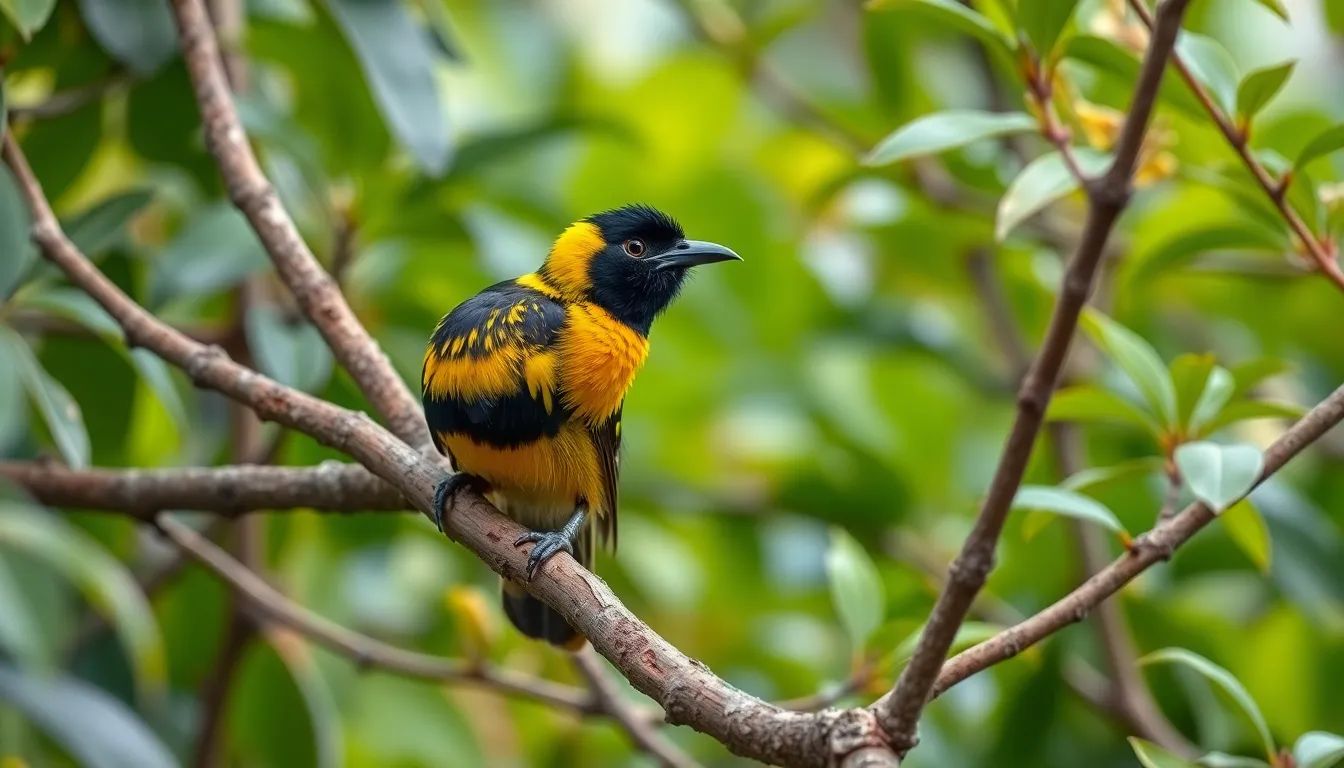
Current population assessments reveal that most weaver bird species maintain stable numbers across their native ranges, though several face mounting pressures from human activities. The International Union for Conservation of Nature (IUCN) classifies 89 weaver bird species as “Least Concern,” while 8 species carry “Near Threatened” status and 4 species are listed as “Vulnerable.”
Madagascar’s endemic weavers face the most critical conservation challenges, with the Sakalava Weaver experiencing a 30% population decline over the past decade. Habitat destruction represents the primary threat to weaver bird populations, as agricultural expansion eliminates 15,000 hectares of suitable nesting habitat annually across Africa. Deforestation in Asian regions removes critical acacia woodlands that support colonial nesting sites for species like the Baya Weaver.
Climate change impacts weaver bird communities through altered precipitation patterns that affect grass seed availability during crucial breeding periods. Extended drought conditions in East Africa reduced Red-billed Quelea populations by 25% between 2016 and 2019. Rising temperatures shift flowering cycles of preferred grass species, creating temporal mismatches between peak food availability and breeding seasons.
| Species | IUCN Status | Population Trend | Primary Threats |
|---|---|---|---|
| Village Weaver | Least Concern | Stable | Urban expansion |
| Sakalava Weaver | Vulnerable | Declining (-30%) | Habitat loss |
| Baya Weaver | Near Threatened | Declining (-15%) | Agricultural conversion |
| Red-billed Quelea | Least Concern | Fluctuating | Pesticide use |
| Golden Palm Weaver | Near Threatened | Declining (-20%) | Palm oil plantations |
Urban development creates additional challenges as expanding cities destroy traditional nesting colonies and fragment habitat corridors. Pesticide applications in agricultural landscapes reduce insect populations that weaver birds depend on during breeding seasons, with organochlorine compounds causing reproductive failures in 40% of exposed colonies.
Invasive plant species alter the composition of grassland ecosystems, replacing native grasses that weaver birds require for nest construction with non-suitable alternatives. Purple loosestrife and giant salvinia infestations in wetland areas eliminate preferred foraging grounds for several African species.
Conservation efforts focus on protecting critical breeding habitats through community-based management programs that involve local populations in monitoring activities. Research initiatives track population dynamics using GPS technology and citizen science networks that document nesting success rates across different regions. Protected area designation covers approximately 35% of prime weaver bird habitat in Africa, though enforcement remains inconsistent across jurisdictions.
Sustainable agriculture practices offer promising answers for maintaining weaver bird populations in cultivated landscapes, with integrated pest management reducing chemical inputs by 60% while preserving beneficial insect communities. Habitat restoration projects reestablish native grass species in degraded areas, creating corridors that connect fragmented populations and support genetic diversity within regional metapopulations.
Conclusion
We’ve explored the remarkable industry of weaver birds and discovered why they’re considered nature’s most skilled architects. Their ability to create complex structures using only grass and instinct continues to amaze researchers and bird enthusiasts alike.
These extraordinary creatures remind us that intelligence and artistry aren’t limited to humans. From their vibrant social communities to their engineering prowess weaver birds have evolved sophisticated systems that ensure their survival across diverse environments.
As we face growing environmental challenges it’s crucial that we support conservation efforts to protect these master builders. By preserving their habitats and promoting sustainable practices we can ensure future generations will witness the spectacular sight of weaver bird colonies thriving in the wild.
The next time you see tall grass swaying in the wind remember that somewhere a weaver bird might be selecting the perfect strand for its next architectural masterpiece.
Frequently Asked Questions
What are weaver birds and where are they found?
Weaver birds are small songbirds belonging to the family Ploceidae, comprising over 100 distinct species. They are primarily found in Africa and Asia, with about 80% of species located in Africa. These birds are renowned for their exceptional nest-building abilities and typically measure 4 to 10 inches in length with specialized beaks adapted for weaving.
How do weaver birds build their nests?
Weaver birds construct intricate nests using only their beaks and fresh grass stems or twigs. Males weave complex structures by employing techniques like knot tying and bending. They create various nest types including pendant nests with entrance tunnels, domed structures, and colonial apartments. Quality control is crucial, as females inspect nests before acceptance.
What do weaver birds eat?
Weaver birds have diverse diets that vary by species and season. Seeds comprise 60-80% of their intake during non-breeding periods, while insects become important during breeding season for protein. They also consume grasses and fruits. Their specialized beaks are adapted for either seed cracking or insect capture, depending on the species.
Are weaver birds suitable as pets?
No, weaver birds are not suitable as pets. They require complex social structures, large flight enclosures, specific temperature and humidity control, and exact dietary needs including fresh branches for nesting. Legal regulations often prohibit their ownership, and conservation organizations advocate against private collections due to their important ecological roles.
What is the conservation status of weaver birds?
Most weaver bird species maintain stable populations, with 89 species classified as “Least Concern” by the IUCN. However, some species like the Sakalava Weaver are “Vulnerable” due to habitat destruction and climate change. Conservation efforts focus on protecting critical habitats, promoting sustainable agriculture, and habitat restoration to support healthy populations.
How do male and female weaver birds differ?
Male weaver birds typically display vibrant yellow and black plumage during breeding season and are responsible for nest construction to attract mates. Females have more subdued earth-toned colors for camouflage and slightly more pointed beaks for nest maintenance and chick feeding. Males often practice polygamy, mating with multiple females based on nest quality.
What types of habitats do weaver birds prefer?
Weaver birds inhabit diverse environments including grasslands, acacia woodlands, wetland edges, agricultural landscapes, and urban parks. African savannas and woodland edges provide optimal conditions for most species, while Asian species adapt to similar grassland and woodland habitats. Each environment offers unique resources supporting their complex colonial lifestyles.

